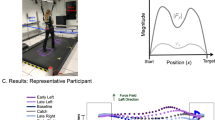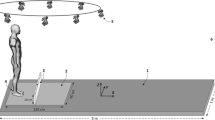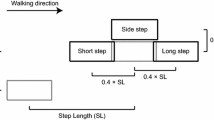Abstract
Two crucial, multi-articular strategies for anticipatory locomotor adjustments (ALA) are knee flexor generation to step over obstacles and hip flexor generation to step up. While lower limb control can be adapted online to modify an already planned obstacle avoidance, or to avoid the sudden appearance of an obstacle, it is not known whether a planned ALA can be substituted by different one online. The present objective was to study such ALA substitutions at two specific timepoints: the final planning stage and the initiation of ALA execution. Ten healthy, young adults (22.0 ± 1.7 years; 5 males) walked in a Virtual Environment (VE) representing the laboratory within a head mounted display. Two blocks of trials, one involving an initial VE with an obstacle (OB) and the other an initial VE with a platform (PL) (heights of 15% of lower limb length for both), were presented, where the initial VE could remain unchanged or be randomly switched between them at one of the two timepoints. The final VE always corresponded to the real environment. Lead limb kinematics, joint kinetics and energetics, as well as electromyography were measured. Repeated measures ANOVAs were used to compare across conditions. Foot clearance, knee flexor generation, and hip flexor generation all changed in the expected directions for the final VEs when requiring early substitution, but not when switched late. These findings show that volitional, locomotor strategies may be substituted at the end of the ALA planning phase, but not once execution is initiated.







Similar content being viewed by others
References
Andujar J-É, Lajoie K, Drew T (2010) A contribution of area 5 of the posterior parietal cortex to the planning of visually guided locomotion: limb-specific and limb-independent effects. J Neurophysol 103:986–1006
Drew T (1993) Motor cortical activity during voluntary gait modifications in the cat. I. Cells related to the forelimbs. J Neurophysiol 70:179–199
Drew T, Marigold D (2015) Taking the next step: cortical contributions to the control of locomotion. Curr Opin Neurobiol 33:25–33
Drew T, Jiang W, Widajewicz W (2002) Contributions of the motor cortex to the control of the hindlimbs during locomotion in the cat. Brain Res Rev 20:178–191
Drew T, Prentice S, Schepens B (2004) Cortical and brainstem control of locomotion. Prog Brain Res 143:251–261
Dugas L, Bouyer L, McFadyen B (2018) Body-foot geometries as revealed by perturbed obstacle position with different time constraints. Exp Brain Res 236:711–720
Elias LJ, Bryden MP, Bulman-Fleming MB (1998) Footedness is a better predictor than is handedness of emotional lateralization. Neuropsychologia 36:37–43
Georgopoulos AP, Grillner S (1989) Visuomotor coordination in reaching and locomotion. Science 245:1209–1210
Higuchi T (2013) Visuomotor control of human adaptive locomotion: understanding the anticipatory nature. Front Psychol 4:277
Kennedy R, Lane N, Berbaum KS (1993) Simulator sickness questionnaire: an enhanced method for quantifying simulator sickness. Int J Aviat Psychol 3:203–220
Lajoie K, Drew T (2007) Lesions of area 5 of the posterior parietal cortex in the cat produce errors in the accuracy of paw placement during visually guided locomotion. J Neurophysiol 97:2339–2354
MacLellan MJ, Dupré N, McFadyen BJ (2011) Increased obstacle clearance in people with ARCA-1 results in part from voluntary coordination changes between the thigh and shank segments. Cerebellum 10(4):732–744. https://doi.org/10.1007/s12311-011-0283-0
MacLellan M, Richards CL, Fung J, McFadyen B (2015) Comparison of kinetic strategies for avoidance of an obstacle with either the paretic or non-paretic as leading limb in persons post stroke. Gait Posture 42:329–334
McFadyen BJ, Carnahan H (1997) Anticipatory locomotor adjustments for accommodating versus avoiding level changes in humans. Exp Brain Res 114:500–506
McFadyen B, Winter D (1991) Anticipatory locomotor adjustments during obstructed human walking. Neurosci Res Comm 9:37–44
McFadyen BJ, Lavoie S, Drew T (1999) Kinetic and energetic patterns for hindlimb obstacle avoidance during cat locomotion. Exp Brain Res 125(4):502–510
Mohagheghi AA, Moraes R, Patla AE (2004) The effects of distant and on-line visual information on the control of approach phase and step over an obstacle during locomotion. Exp Brain Res 155:459–468
Neptune R, Zajac F, Kautz S (2004) Muscle force redistributes segmental power for body progression during walking. Gait Posture 19:194–205
Patla AE, Greig M (2006) Any way you look at it, successful obstacle negotiation needs visually guided on-line foot placement regulation during the approach phase. Neurosci Lett 397:110–114
Patla A, Prentice S (1995) The role of active forces and intersegmental dynamics in the control of limb trajectory over obstacles during locomotion in humans. Exp Brain Res 106:499–504
Patla AE, Vickers JN (1997) Where and when do we look as we approach and step over an osbtacle in the travel path? Neuroreport 8:3661–3665
Patla A, Beuter A, Prentice S (1991) A two stage correction of the limb trajectory to avoid obstacles during stepping. Neurosci Res Commun 8:153–159
Prentice SD, Hasler EN, Groves JJ, Frank JS (2004) Locomotor adaptations for changes in the slope of the walking surface. Gait Posture 20(3):255–265
Queralt A, Weerdesteyn V, Van Duijnhoven HJ, Castellote JM, Valls-Solé J, Duysens J (2008) The effects of an auditory startle on obstacle avoidance during walking. J Physiol 586:4453–4463
Slater M, Usoh M, Steed A (1994) Depth of presence in virtual environments. Presence Teleoper Virtual Environ 3:130–144
Weerdesteyn V, Nienhuis B, Hampsink B, Duysens J (2004) Gait adjustments in response to an obstacle are faster than voluntary reactions. Hum Mov Sci 23:351–363
Whittington B, Silder A, Heiderscheit B, Thelen D (2008) The contribution of passive-elastic mechanisms to lower extremity joint kinetics during human walking. Gait Posture 27:628–634
Winter DA (1987) Sagittal plane balance and posture in human walking. IEEE Eng Med Biol Mag 6:8–11
Witmer BG, Singer MJ (1998) Measuring presence in virtual environments: a presence questionnaire. Presence Teleoper Virtual Envir 7:225–240
Yakovenko S, Krouchev N, Drew T (2011) Sequential activation of motor cortical neurons contributes to intralimb coordination during reaching in the cat by modulating muscle synergies. J Neurophysiology 105:388–409
Acknowledgements
The authors thank N. Robitaille (programming), S. Forest (infrastructure construction) and G. St-Vincent (motion capture) for valuable technical assistance and Frédéric Dumont for assistance with the manuscript preparation. We also thank Dr. Philippe Jackson for the use of the HMD. This work was funded by the Natural Sciences and Engineering Research Council of Canada (RGPIN/191782-2017).
Author information
Authors and Affiliations
Corresponding author
Rights and permissions
About this article
Cite this article
McFadyen, B.J., Fiset, F. & Charette, C. Substituting anticipatory locomotor adjustments online is time constrained. Exp Brain Res 236, 1985–1996 (2018). https://doi.org/10.1007/s00221-018-5277-4
Received:
Accepted:
Published:
Issue Date:
DOI: https://doi.org/10.1007/s00221-018-5277-4




